The topic of chilling after cooking sous-vide, also referred to as “shocking” or “ice bath”, is frequently debated in sous-vide support groups on Facebook. Some people insist chilling after sous vide should always be done, others don’t understand its use if the food you’ve cooked sous-vide is going to be eaten right away.
The purpose of chilling in an ice bath after cooking sous vide if the food is going to be stored is clear: by chilling in an ice bath, the food will cool as quickly as possible. This limits the chance for harmful bacteria to grow during the cooling process. For food safety reasons you should always chill the core of food that has been cooked sous vide to 5C/40F or less in less than 2 hours. Especially for thicker/larger food items, an ice bath may be needed to achieve that. Furthermore, putting food that is still warm in your refrigerator, will heat up your refrigerator and may limit the shelf life of other food items in there.
Cooking food sous-vide and then chilling it completely to 5C/40F or less makes sense in the following situations:
- Meat that needs to be cooked sous-vide longer than just to warm it through can be cooked until tender, chilled (and possibly frozen), and then reheated sous-vide until heated through again. This is especially useful and saves energy when you are cooking multiple portions at the same time. Restaurants do this all the time.
- For meat that only needs to be heated through, this only makes sense for thin steaks and other meat that is thin (2 cm, 3/4 inch or less), where searing the meat will also bring it to serving temperature, so reheating sous-vide is not necessary. This is also something that restaurants do all the time. More about this below.
The theories presented by the chilling-fundamentalists for also chilling meat after sous-vide if you are going to eat it right away did not always make sense to me, but I wanted to find out for myself (and for my readers) exactly when it is useful, and when it is not. And so another round of experiments was in order. This is the longest post I’ve ever written on this blog and the largest amount of experiments I’ve done for a single post. There are worse things than having ribeye steak or fillet mignon for lunch though, so I am not complaining. I’ve experimented with steak, but the teachings from this post are applicable to all meat that is cooked sous vide as well as seared.
Before we dive into the experiments, allow me to introduce what we are trying to achieve and what role chilling could play to reach that goal. We want to cook a steak that is:
- Cooked evenly to the desired core temperature for the doneness we prefer, such as 55C/131F for medium rare or 60C/140F for medium.
- Seared on the outside for a nice crust.
- Served warm.
The fillet mignon in the photo above was cooked in the traditional way without sous-vide: sear it first, and then finish it in the oven until the desired core temperature (of in this case 50C/122F). It meets the criteria of being seared on the outside and being served warm, but as you can see the cooking is far from even. A very large portion of the fillet mignon is overcooked. Only the center is rare to medium rare.
The fillet mignon shown above is a good example of what an evenly cooked fillet mignon looks like. This one was cooked sous-vide and meets all three criteria: perfectly medium rare from edge to edge, seared, and served warm. Do you need chilling to achieve this result? Read on to find out!
For the experiments I used ribeye steaks of approximately 2 cm (3/4 inch) thick…
…and fillet mignon (beef tenderloin, beef fillet) of approxiamtely 4 cm (1 1/2 inch) thick. Each was about 150 grams (5-6 oz), so a nice portion for my post-workout meal in the weekend. As we will see, the thickness plays an important role in determining how to achieve a well seared, evenly cooked steak at the right serving temperature.
All of the steaks were salted before vacuum sealing.
As a first experiment, I cooked two ribeye steaks of 2 cm (3/4 inch) thick sous vide for 2 hours…
at 52C/126F. I chose this temperature as my personal preference for the rare side of medium rare, but the results with respect to chilling or not will be the same regardless of your desired doneness.
Both steaks were cooked at the same time…
…but one of them was chilled immediately after sous vide cooking and kept overnight in the refrigerator. Please note that I could have added ice cubes for faster chilling, but with a steak as thin as this cold tap water followed by the refrigerator is quick enough.
It’s interesting to note that after sous vide cooking, the thermometer showed a core temperature of the steak that was going to be seared of only 43C/109F, even though it had been close to 52C/126F in the sous vide just minutes ago. This goes to show quickly such a thin steak cools off (as well as the initial temperature of the probe).
I weighed the steak (after patting it dry with paper towels) and from 2 hours of cooking it had gone down from 148 grams to 141 grams, or a loss of juices caused by the sous vide cooking of 5%.
Then I seared the steak in clarified butter in a very hot frying pan for 1 minute per side, turning just once.
From the searing the steak lost an additional 25 grams of water, so compared to the original weight of the steak we have a loss of 22% in total.
Measuring the core temperature shows that from the searing it has gone up to 60C/140F.
This is also clear if we look inside the steak: it is medium rather than medium rare.
So by cooking the steak at 52C/126F and searing it right away without chilling, it actually ends up with a core temperature of 60C/140F and is medium. So this is the reason why some chilling can make sense if you are going to eat the steak straight after sous vide cooking.
The next day I took the chilled steak out of the refrigerator…
…and weighed it, after patting it dry. This steak has gone down from 151 grams to 142 grams, or a moisture loss of 6%.
I seared this steak in the same way: 1 minute per side in clarified butter over very high heat.
The final weight loss this steak was 21%, so slightly less than the steak that was seared right away. (Although I doubt that anyone could perceive such a small difference when tasting the steak.)
The core temperature of this steak after searing was only 45C/113F, which is just warm enough for serving (since the outside is piping hot).
This steak is perfectly medium rare inside.
This method is great for restaurants, because you can have a large amount of steaks already cooked sous vide at different levels of doneness (medium rare, medium, etc.) in the refrigerator and it only requires 2 minutes (1 minute of searing per side) to finish them and bring them to serving temperature.
But can we conclude that chilling the steak fully to 5C/40F before searing is the best approach also for home cooks, as is stating by the ‘chilling fundamentalists’?
Not really, because the thickness of the steak plays an important role, and because there are other strategies to end up with a well seared, evenly cooked steak at the right serving temperature that take less time and with a better serving temperature.
But before we dive into those other strategies, let’s first look at why chilling the steak fully after sous vide and before searing goes wrong with a thick steak.
I cooked a 4 cm (1 1/2 inch) thick fillet mignon for 2 hours at 52C/126F and then chilled it fully.
Afterwards I seared it for 1 minute per side in clarified butter over high heat.
Because of the thickness, I wrapped the fillet mignon in foil and allowed it to rest for 5 minutes to allow the center to warm up.
Even so, the core temperature ended up at only 41C/106F…
…and together with the outside that was no longer piping hot, the serving temperature was just too low.
It would have been possible to increase the serving temperature by searing for a longer time or even by using the oven, but that would lead to an uneven cooked fillet mignon and I really don’t understand why you would first cook a fillet mignon sous vide and then cook it again the traditional way (sear + oven), as you could just as well leave out the sous vide step. Or you could reheat it sous vide before searing, but then there was no need to have already cooked it sous vide before chilling it.
Let’s go back to the 2 cm (3/4 inch) ribeye steak and the strategies to get the correct and even doneness combined with a good serving temperature.
One strategy is to lower the sous vide temperature. I tried lowering it from 52C/126F to 47C/108F, followed by the same sear of 1 minute per side. It still ended up with a core temperature of 60C/140F, so that didn’t work.
As you can see it has turned out medium.
What did work, was to cook it at 50C/122F, and sear for only 30 seconds per side. The drawback of searing for a shorter time however is a crust that is less crispy and flavorful.
To be able to sear a 2 cm (3/4 inch) steak for 1 minute per side to get a good sear, some chilling is needed. Chilling for 10 minutes in cold tap water (no ice) was enough to be able to sear a steak that had been cooked at 52C/126F for 1 minute per side, and ending up with the same serving temperature of 45C/113F as the steak that had been chilled overnight. That is a lot faster. Chilling for 5 minutes instead of 10 minutes could be a strategy to end up with a warmer serving temperature, but could lead to an overcooked steak.
For a 2 cm (3/4 inch) steak cooked sous vide at 50C/122F, searing for 1 minute per side without chilling first was too long. But for a 4 cm (1 1/2 inch) steak cooked sous vide at 50C/122F, searing for 1 minute per side without chilling, resulted in a core temperature of 52C/126F.
This is how I usually do fillet mignon, because it is such a simple method and will yield a steak that is evenly done and a perfect serving temperature. I set the sous vide temperature a bit lower than what I am aiming for, and then the searing will take it to the right temperature. However, this method only works for thicker steaks, as thinner steaks will overcook much more easily than thick steaks.
Another method for fillet mignon is to sear the steak 1 minute per side BEFORE sous vide.
This is more complicated, because the steak has to be chilled before it can be vacuum sealed.
Then it was cooked sous vide at 52C/126F for 2 hours…
…and ready to be served.
The major drawback is that method that the outside is not piping hot and the crust is no longer crispy. You can fix this with a very short sear in a fying pan over high heat (30 seconds or less per side), or with a torch.
The result is again a perfectly cooked fillet mignon. The advantage of this method compared to cooking the fillet mignon a few degrees lower than the doneness you want and then searing it, is that by searing first you have perfect control over the final doneness. If you sear afterwards, it can end up a bit more done or a bit less done than you wanted.
Conclusions
From these experiments we can draw the following conclusions:
- Chilling meat fully to 5C/40F or less after sous vide is only necessary if you are going to store the meat after sous vide cooking to finish and eat it later. It is important to chill the core of the meat to 5C/40F or less within 2 hours. Cold tap water will be quick enough for thin meat, especially if the meat was cooked to pasteurization. For thick meat ice water is needed to chill it quick enough.
- If you cook a steak sous vide to eat right away, it depends on the thickness of the steak and how long you want to sear it, whether some chilling can be helpful.
- For a thin steak of 2 cm (3/4 inch) or less:
- chill the steak for at least 10 minutes in cold tap water before doing a long sear (1 minute per side). If you are going to sear for a longer time than that, consider not cooking it sous vide at all, because you are going to ruin the even doneness with the long sear anyway.
- sear the steak right away without chilling if seared for a short time (30 seconds or less per side) AND you cook it sous vide a few degrees lower than the doneness you want.
- if the steak has been chilled completely after sous vide cooking, it can be finished and reach a proper serving temperature just by searing. The searing time will depend on the thickness. 1 minute per side works well for 2 cm (3/4 inch), but will be too much if the steak is really thin, like veal scaloppine.
- For a thick steak of 2.5 cm (1 inch) or more:
- sear the steak right away without chilling if seared for a short time (30 seconds or less per side). For a thick steak, especially if it is 4 cm (1 1/2 inch) or more, there is no need to reduce the sous vide temperature, because there is less risk of overcooking it by searing.
- if you want to sear the steak for a longer time (1 minute per side), reduce the sous vide temperature by a few degrees OR chill the steak in cold tap water for 5 minutes before searing.
- if the steak has been chilled completely after sous vide cooking, it has to be reheated sous vide before you can finish it, as otherwise the serving temperature in the center will be too low. This is why cooking thick steaks sous vide and then chilling them, only makes sense if you want to cook them for a longer time than needed to heat them through to make them more tender.
- Pre-searing and then cooking sous vide is an alternative method to get a good result with more precise control of the final doneness if you want a strong sear. You can do a short post-sear (30 seconds or less per side) for crispness and serving temperature.
Myth busting
To end, let me bust some of the myths about chilling after sous vide cooking.
One of the reasons cited by ‘chilling fundamentalists’ is that the steak will reabsorb the juices that it lost during the cooking, and as we can saw from a simple measurement in the experiment that is clearly not the case. On the contrary, from the measurement that I did, the loss of moisture was even slightly higher than the steak that had not been chilled after cooking sous vide. (I remember a very confused Italian in an Italian sous vide Facebook group. He had learned in an Italian sous vide course by the self-proclaimed leading Italian sous vide chef that chilling the meat will make it reabsorb the juices. So he was really surprised to find that after a night in the refrigerator, there was still so much juice in the bag outside of the meat.)
Another reason for chilling and allowing the meat to ‘rest’ overnight in the refrigerator is that will ‘stabilize the juices’. However, the meat has already rested in the sous vide water bath. After the core of the meat has (almost) reached the temperature of the water bath, which with a steak of 2 cm (3/4 inch) only takes 35 minutes, the temperature of the juices in the meat is the same throughout the meat, so the meat is already rested and stabilized when it comes out of the sous vide! (Resting after cooking with high heat such as pan frying or grilling does make sense, because then the temperature on the outside of the meat is much higher than the core.)
And finally, it is said that chilling is needed to ‘stop the cooking process’. Although strictly speaking there is some truth to that, it has no practical meaning for three reasons:
- The outside of the meat has been cooked for a longer time than the inside, because it has taken longer for the inside to reach the cooking temperature. So it is not necessarily a bad thing that on the inside the cooking process will continue for a bit after you take the meat out of the sous vide.
- With sous vide we cook ‘low and slow’. Because of the slow cooking process, there is a pretty big window in which the food is properly cooked and not even the best trained palates can tell the difference.
- Because we often cook sous vide at low temperatures, the food needs only to cool down a bit to lower the temperature below a level where any ‘cooking’ occurs. For meat, that is roughly about 50C/122F. If we cook sous vide at 55C/131F or 57C/135F, it is not going to take a long time for the temperature to drop below 50C/122F.
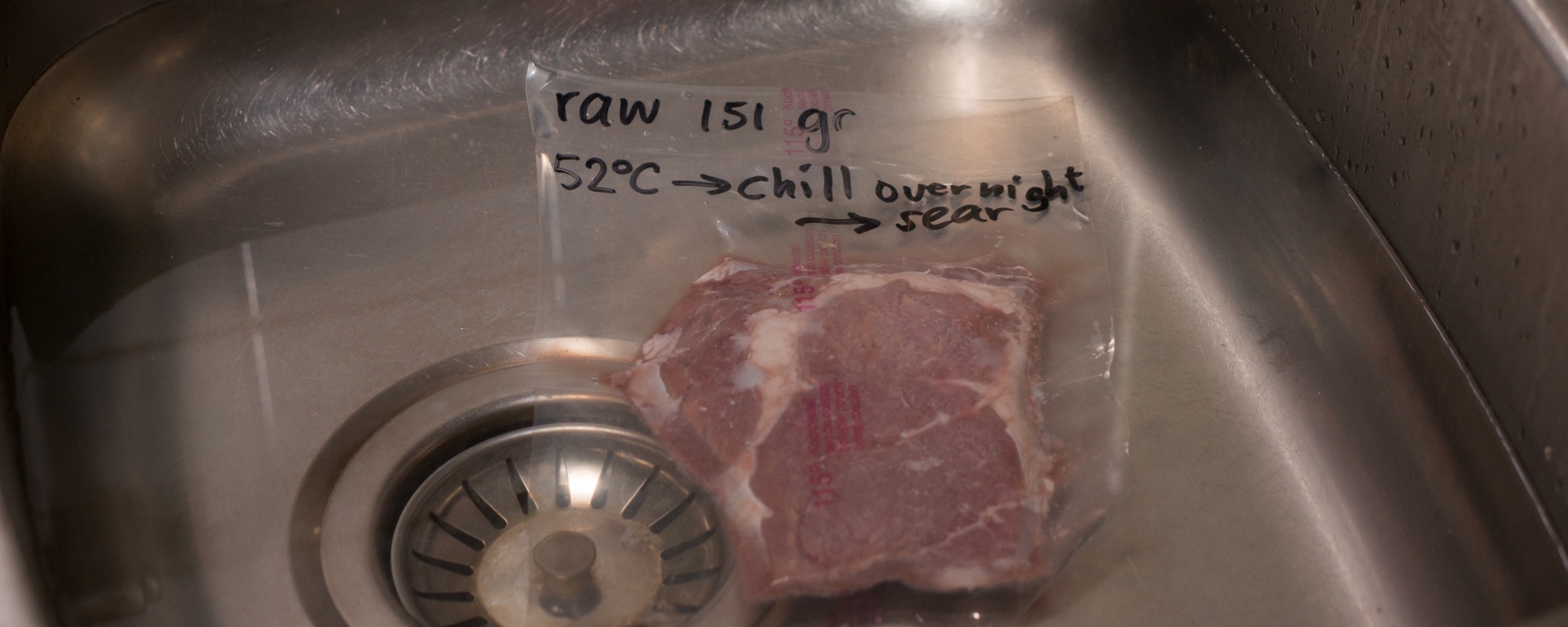





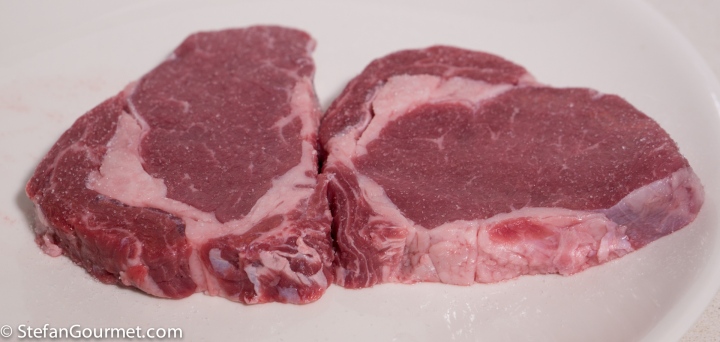
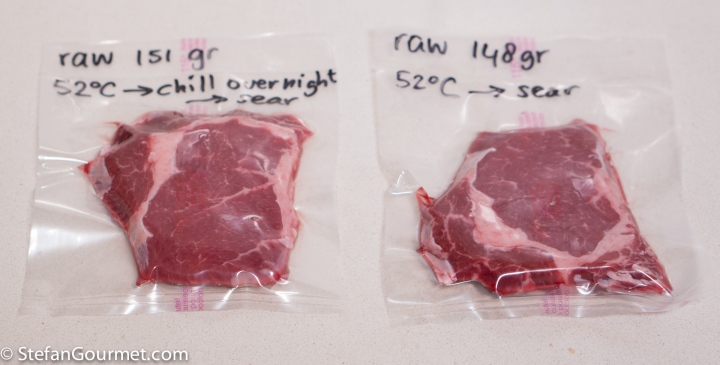

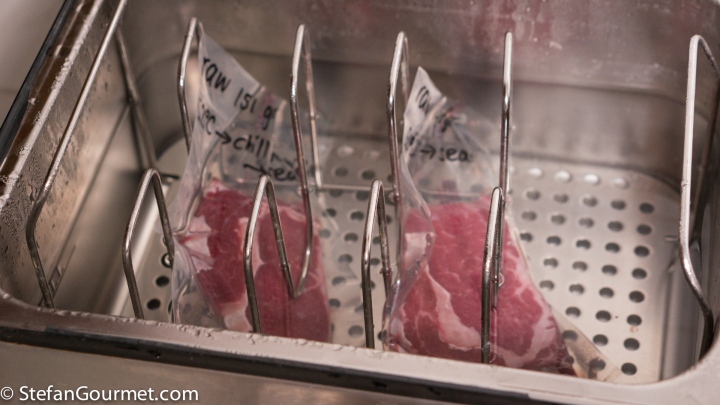
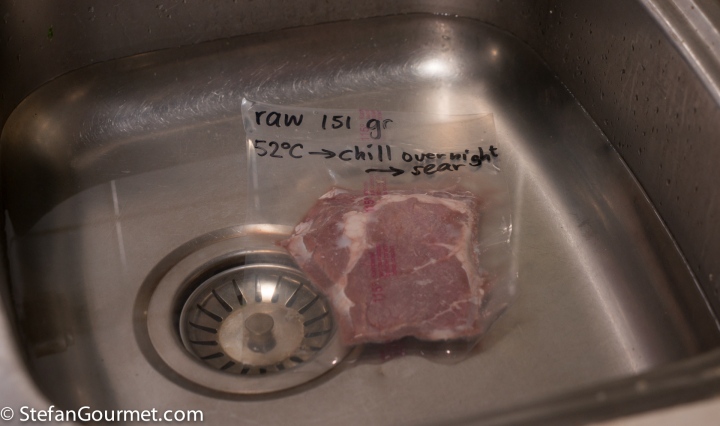
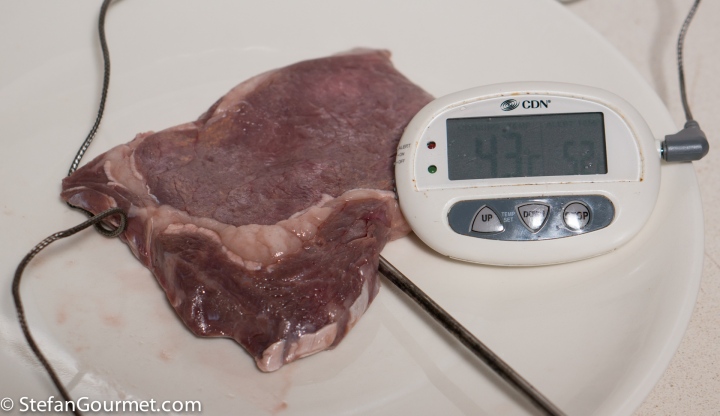



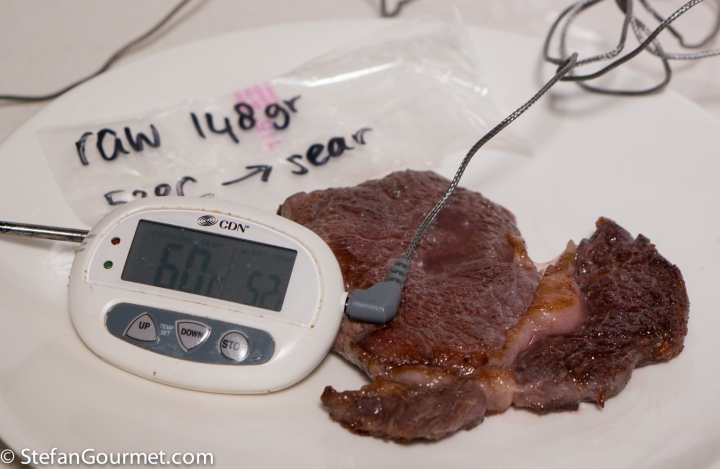

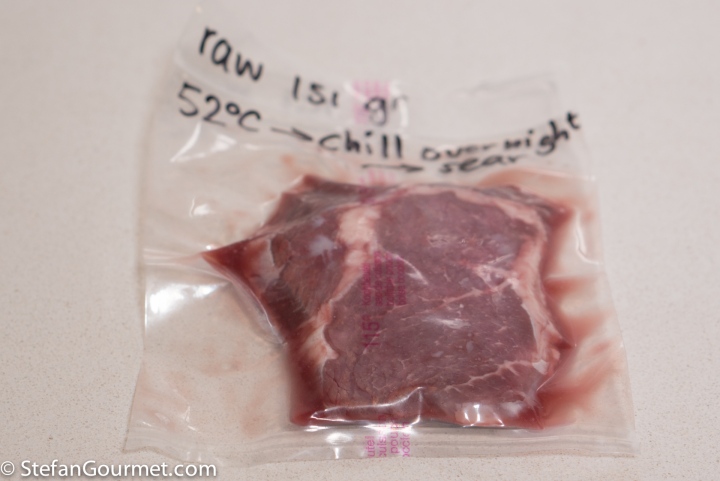

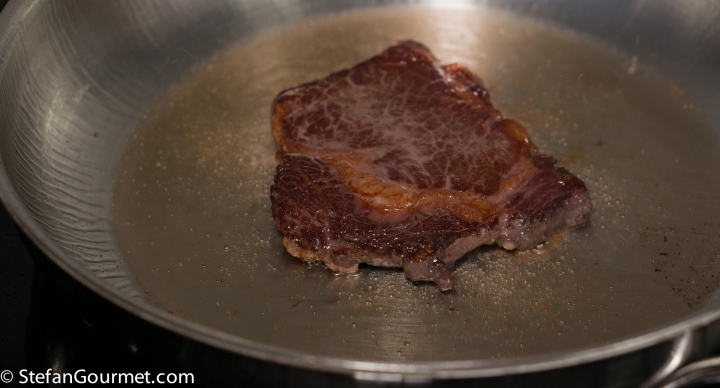
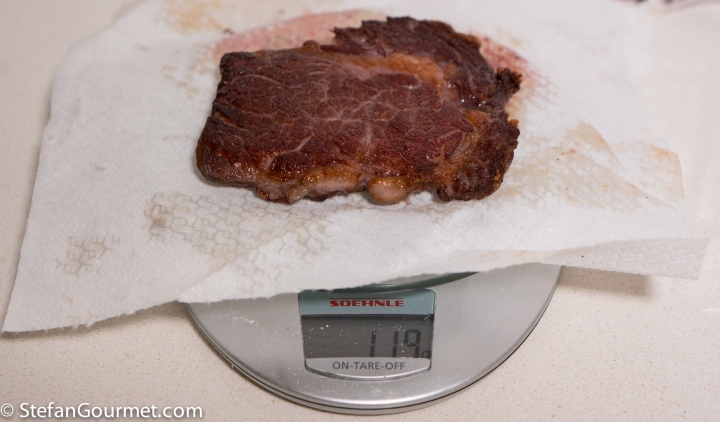






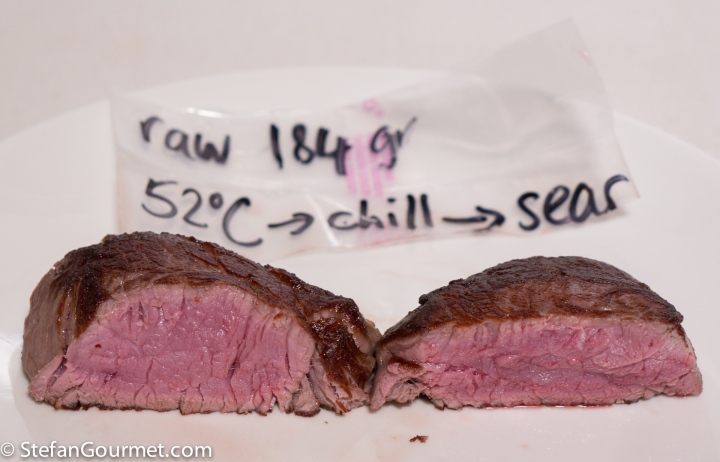


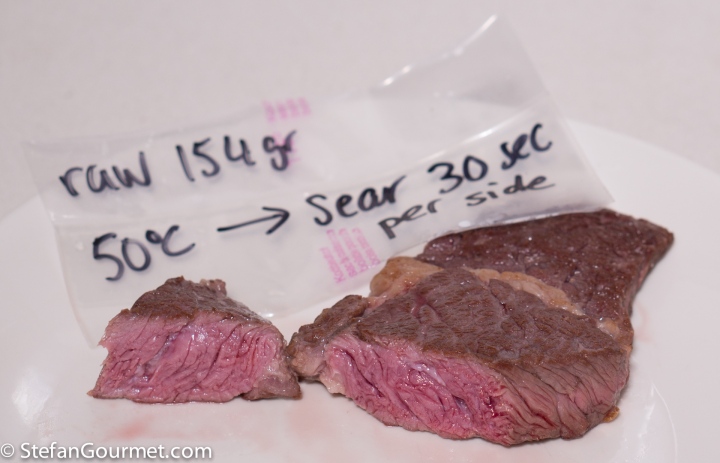
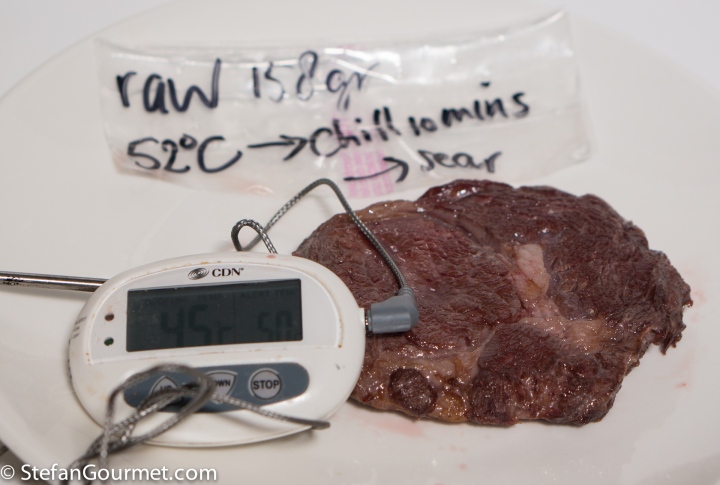







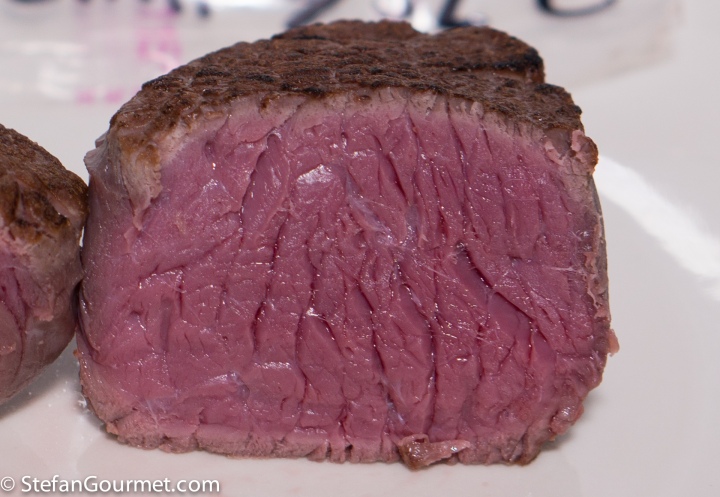

Great work Stefan. Thank you for your thorough approach. Maybe you should start a television series “Sous-Vide Mythbusturs”.
LikeLiked by 1 person
You missed one method, the one actually used in restaurants. PREP -Pre-sear, sous vide, ice shock, refrigerate. SERVICE- sous vide (to a temp slightly below prep sous vide. In your case let’s say 48c), hold up to 90 minutes ready to fire when ordered, second sear to order, serve. RESULT- crispy outside, 48C inside and perfectly done to the original sous vide temp no matter the thickness of the steak. That is why people still eat steaks in restaurants because chefs go the extra mile..
LikeLike
Hi Trev, I like the double sear. However, if you keep the steak at 48C then the second sear without chilling first will have to be very brief to avoid overcooking (depending on thickness).
LikeLike
Trev, when following this restaurant method, when is seasoning applied?
LikeLike
Dit is “wetenschap” Stefan. Knap gedaan en wat voor geduld moet jij hebben!
LikeLiked by 1 person
Articolo super! Nel mio piccolo aggiungo che, per l’igiene, tutto il cibo andrebbe refrigerato subito appena cotto, se non lo si consuma subito
LikeLiked by 1 person
Great experiment.
LikeLiked by 1 person
Amazing! and Bravo! Such great information.
LikeLiked by 1 person
Sous Vide pasteurizes the meat. Meaning you have killed all the bacteria.
LikeLike
Hi Derek,
Pasteurization does kill the bacteria but not the spores, so you still need to chill the meat and keep it refrigerated after sous vide cooking. Otherwise the bacteria will grow back from the spores.
Hope this helps,
Stefan
LikeLike
Hi Stefan
I am always confused when it comes to chilling, on the reheating part, from a health pint of view.
I understand from your post that for thin meats (including chicken?) although the food is brought down to 5C quickly enough, when it is time to cook, we remove from the refrigerator and simply sear and that is enough.
On thicker meats, the ice bath is used and when it is time to reheat, we need to to sous-vide again in order to reach the proper temperature. Following the tables, this might be in the hours, so how does that work?
Thank you. Live the blog, great source of knowledge
LikeLike
For thicker meats for food safety it is best to cook sous-vide, chill, and then reheat only if the sous-vide cooking and the reheating are done at 52C/126F or higher. That way, any bacteria that were on the meat when you started cooking can’t grow during the sous-vide cooking, so chilling and reheating can be done safely. If you want to cook thick meat sous-vide at a lower temperature, it is recommended to finish and serve right after sous-vide cooking. For more about food safety, go here: https://stefangourmet.com/2016/11/27/understanding-food-safety/
LikeLike
This is amazing, thank you for the great writeup. The problem I am having is my wife wanting the meat hotter at serving time; she doesnt like the ‘room temp’ feeling of the meat after a sous vide and sear (she prefers medium doneness). As you said above the steak loses a ton of temp quickly once you take it out. I tried putting it on her plate immediately after sear but she still wasn’t satisfied. Any tips on getting a higher inner core temp for the final serving?
LikeLike
Hi Luke,
The inner core temperature is directly related to the doneness. So if your wife wishes medium, then the core temperature will always be 60C/140F. If you make it any hotter, it will be more well done.
What will help is to use preheated plates, to use a thick steak (shaped like fillet mignon), to sear the steak at least 1 minute per side, and to make sure that the serving core temperature is indeed 60C/140F.
This should help!
Good luck,
Stefan
LikeLike
This is a great article. Many thanks for sharing your experiment and explaining everything so well.
Your articles mentions: “Another method for fillet mignon is to sear the steak 1 minute per side BEFORE sous vide. This is more complicated, because the steak has to be chilled before it can be vacuum sealed.” Why does it need to be chilled before it can be vacuum sealed?
LikeLike
If you vacuum seal it when it is still warm, you will draw many juices out of the meat.
LikeLike